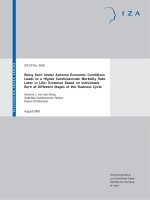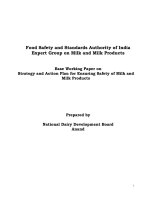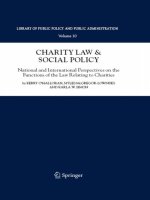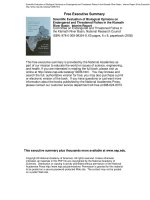Different functions of notch activation on formation and maintenance of rhombomere boundaries
Bạn đang xem bản rút gọn của tài liệu. Xem và tải ngay bản đầy đủ của tài liệu tại đây (5.38 MB, 239 trang )
STUDY OF CHITOSAN-BASED BIOPOLYMER ADSORBENTS
AND THEIR APPLICATIONS IN HEAVY METAL REMOVAL
LI NAN
NATIONAL UNIVERSITY OF SINGAPORE
2006
STUDY OF CHITOSAN-BASED BIOPOLYMER ADSORBENTS
AND THEIR APPLICATIONS IN HEAVY METAL REMOVAL
LI NAN
(B.Eng. WUHAN UNIV)
A THESIS SUBMITTED
FOR THE DEGREE OF DOCTOR OF PHILOSOPHY
DEPARTMENT OF CHEMICAL AND BIOMOLECULAR
ENGINEERING
NATIONAL UNIVERSITY OF SINGAPORE
2006
ACKNOWLEDGEMENT
First of all, I would like to express my cordial gratitude to my supervisor, A/P Bai
Renbi for his heartfelt guidance, invaluable suggestions, and profound discussion
throughout this work, for sharing with me his enthusiasm and active research interests,
which are the constant source for inspiration accompanying me throughout this project.
The valued knowledge I learned from him on how to do research work and how to
enjoy it paves my way for this study and for my life-long study.
I would like to thank all my colleagues for their help and encouragement, especially to
Mr. Lim Aikleng, Ms. Liu Chunxiu, Mr. Liu Changkun, Mr. Wee Kin Ho and Mr. Han
Wei. In addition, I also appreciate the assistance and cooperation from lab officers
and technicians of Department of Chemical and Biomolecular Engineering.
Finally, I would like to give my most special thanks to my parents, Mr. Li Xiusheng
and Ms. Wu Meiju, my sister, Miss Li Hao and my husband, Dr. Cai Qinjia for their
continuous love, support, and encouragement.
I
TABLE OF CONTENTS
ACKNOWLEDGEMENT I
TABLE OF CONTENTS II
SUMMARY VI
LIST OF TABLES IX
LIST OF FIGURES X
LIST OF SCHEMES XIV
LIST OF SYMBOLS XV
NOMENCLATURE XVII
CHAPTER 1 INTRODUCTION 1.
1.1 Overview 2.
1.2 Objectives and scopes of the study 7.
CHAPTER 2 LITERATURE REVIEW 10.
2.1 Heavy metal pollution 11.
2.1.1 General 11.
2.1.2 Copper, Lead and Mercury 13.
2.1.2.1 Copper (Cu) 13.
2.1.2.2 Lead (Pb) 15.
2.1.2.3 Mercury (Hg) 16.
2.2 Methods for heavy metal removal 19.
2.3 Bioadsorption 24.
2.3.1 Seaweed 25.
2.3.2 Alginate 25.
2.3.3 Dead biomass and rice hulls 26.
2.3.4 Chitin and chitosan 27.
2.3.4.1 Physical and chemical properties of chitosan 28.
2.3.4.2 Application of chitosan in water treatment 30.
CHAPTER 3 STUDY OF CHITOSAN-CELLULOSE HYDROGEL BEADS
FOR COPPER ADSORPTION: BEHAVIORS AND MECHANISMS 41.
II
3.1 Introduction 42.
3.2 Materials and methods 45.
3.2.1 Materials and chemicals 45.
3.2.2 Preparation of chitosan-cellulose hydrogel beads 45.
3.2.3 Swelling, hydration rate, dissolution and mechanical property test 47.
3.2.4 Zeta potential measurement 49.
3.2.5 Adsorption experiments 50.
3.2.5.1 Copper adsorption at different solution pH 50.
3.2.5.2 Adsorption equilibrium study 51.
3.2.5.3 Kinetic adsorption experiments 52.
3.2.6 Surface morphology observation with SEM 53.
3.2.7 Fourier tranform infrared (FTIR) spectroscopy 53.
3.2.8 X-ray photoelectron spectroscopy (XPS) 54.
3.3 Results and discussion 55.
3.3.1 Surface morphology 55.
3.3.2 Swelling, hydration, solubility and mechanical properties 59.
3.3.3 Zeta potentials 64.
3.3.4 Characterization of chitosan-cellulose beads 65.
3.3.5 Effect of pH on copper adsorption 70.
3.3.6 Adsorption isotherms 73.
3.3.7 Adsorption kinetics 78.
3.3.8 Adsorption mechanisms 81.
3.4 Conclusion 88.
CHAPTER 4 A NOVEL AMINE-SHIELDED SURFACE CROSSLINKING
OF CHITOSAN HYDROGEL BEADS FOR ENHANCED METAL
ADSORPTION PERFORMANCE 89.
4.1 Introduction 90.
4.2 Materials and methods 93.
4.2.1 Materials and chemicals 93.
4.2.2 Preparation and crosslinking chitosan hydrogel beads 93.
4.2.3 SEM observation 95.
4.2.4 Zeta potential measurement 95.
4.2.5 Adsorption experiments 95.
4.2.6 FTIR analysis 97.
4.2.7 XPS study 98.
4.3 Results and discussion 99.
4.3.1 Surface treatments and crosslinking mechanisms 99.
4.3.2 Zeta potentials 111.
4.3.3 Adsorption performance 112.
4.3.4 Adsorption mechanisms 117.
4.4 Conclusions 122.
III
CHAPTER 5 ENHANCED AND SELECTIVE ADSORPTION OF
MERCURY IONS ON CROSSLINKED CHITOSAN BEADS GRAFTED
WITH POLYACRYLAMIDE VIA SURFACE-INITIATED ATOM
TRANSFER RADICAL POLYMERIZATION 123.
5.1 Introduction 124.
5.2 Materials and methods 127.
5.2.1 Materials 127.
5.2.2 Preparation of chitosan beads 127.
5.2.3 Polymerization of acrylamide on chitosan beads through ATRP method 127.
5.2.4 Metal adsorption experiments 129.
5.2.5 Desorption experiments 131.
5.2.6 Surface analyses 131.
5.3 Results and discussion 132.
5.3.1 Surface modification reactions 132.
5.3.2 Mercury adsorption kinetics 147.
5.3.3 Equilibrium adsorption of mercury ions 149.
5.3.4 Effect of pH on selective or competitive adsorption of mercury and lead 151.
5.3.5 Mechanism of selective adsorption 155.
5.3.6 Desorption of adsorbed metal Ions on chitosan-g-polyacrylamide beads 162.
5.4 Conclusion 164.
CHAPTER 6 HIGHLY EFFECTIVE REMOVAL OF LEAD IONS WITH
CROSSLINKED CHITOSAN BEADS GRAFTED WITH POLYACRYLIC
ACID CHAINS 165.
6.1 Introduction 166.
6.2 Materials and methods 169.
6.2.1 Materials 169.
6.2.2 Preparation of PAAc-grafted chitosan beads 169.
6.2.3 Lead adsorption experiments 170.
6.2.4 Desorption experiments 171.
6.2.5 FESEM observation 172.
6.2.6 Zeta potential measurement 172.
6.2.7 FTIR analyses 172.
6.3 Results and discussion 173.
6.3.1 Grafting of PAAc on DCHB beads 173.
6.3.2 Zeta potentials 179.
6.3.3 Adsorption performance at different solution pH values 180.
6.3.4 Adsorption isotherms 181.
6.3.5 Adsorption kinetics 186.
6.3.6 Desorption study 188.
6.3.7 Adsorption mechanism of lead ions on DCHB-PAAc beads 190.
6.4 Conclusions 195.
IV
CHAPTER 7 CONCLUSIONS AND RECOMMENDATIONS 196.
7.1 Conclusion 197.
7.2 Recommendations and future work 200.
REFERENCE 203.
LIST OF PUBLICATIONS 218.
V
SUMMARY
Biopolymers have attracted great research interests in their use as adsorbents in recent
years. Chitosan, a derivative of chitin, a natural biopolymer existing in various
crustacean biomasses and being widely available from seafood industry waste, has
been extensively studied as an adsorbent for the removal of heavy metal ions and
natural organic matters from aqueous solutions, largely attributed to the non-toxicity of,
and the presence of the free amine and hydroxyl groups in chitosan. The purpose of
this study was to develop novel chitosan-based biopolymer granular adsorbents for
enhanced removal of heavy metal ions. The research included synthesis and
characterizations of mechanically strong chitosan-cellulose hydrogel beads through
polymer blending, improvement of chitosan hydrogel beads for acid resistance by
novel amine group protected crosslinking and functionalizations of chitosan beads
through surface grafting for selective and enhanced adsorption of heavy metal ions.
In the first part of the study, chitosan was blended with cellulose to make
chitosan-cellulose hydrogel beads and the hydrogel beads were crosslinked with
ethylene glycol diglycidyl ether (EGDE). It was found that the addition of cellulose
into chitosan made the hydrogel beads materially denser (hence mechanically stronger)
and crosslinking improved the chemical stability of the chitosan-cellulose beads in
solutions with pH values down to 1. Batch adsorption experiments for copper ion
removal showed that both chitosan-cellulose and crosslinked chitosan-cellulose
hydrogel beads had reasonably high adsorption capacities for copper ions, although the
crosslinked chitosan-cellulose beads exhibited lower adsorption capacities than the
VI
non-crosslinked beads, attributed to the consumption of the amine groups of chitosan
in the crosslinking process.
Then, a new amine-shielded crosslinking method of the chitosan beads with ethylene
glycol diglycidyl ether (EGDE) was attempted in order to improve the metal adsorption
performance of the crosslinked chitosan beads. Most of the amine groups in chitosan
were converted to –N=CH
2
groups through formaldehyde treatment and hence they were
not involved in the crosslinking reaction with EGDE. A final treatment of the beads with
a HCl solution after the crosslinking reaction effectively released the shielded nitrogen
atoms in the –N=CH
2
groups into the form of the primary amine. Copper ion adsorption
experiments confirmed that chitosan beads crosslinked with the new method had
significantly greater adsorption capacities than the beads crosslinked with the traditional
method.
Another effort has been made toward the selectivity of the adsorbent in the removal of
heavy metal ions from aqueous solutions. Chitosan beads were modified through
surface grafting and polymerization of acrylamide, via a surface-initiated atom transfer
radical polymerization (ATRP) method, to achieve enhanced and selective removal of
mercury ions. The chitosan-g-polyacrylamide beads were found to have significantly
greater adsorption capacity and faster adsorption kinetics for mercury ions than
chitosan beads. In co-adsorption experiments with both mercury and lead ions, the
chitosan-g-polyacrylamide beads showed excellent selectivity for mercury ion
adsorption over lead ions, in contrast to chitosan beads which did not show clear
selectivity for either of the two metal species. Mechanism study suggested that the
selectivity in mercury ion adsorption with chitosan-g-polyacrylamide beads can be
VII
attributed to the ability of mercury ion to form covalent bonds with the amide groups
of the beads.
A final attempt was made to increase or enhance the adsorption capacity of crosslinked
chitosan beads for their effective applications in acidic solution. Chitosan beads were
crosslinked by the conventional method and then grafted with polyacrylic acid (PAAc)
via a simple and environmental friendly two-step surface modification method. Zeta
potential analysis showed that the modified beads had negative zeta potential at pH
greater than 4, which favored the adsorption of cation metal ions at a wider pH range
(pH > 4), as compared to chitosan (DCHB) beads at only pH > 6.7. Adsorption
experiments showed that the modified chitosan-polyacrylic acid (DCHB-PAAc) beads
had much greater adsorption capacity for lead ions than the DCHB beads at all the pH
values studied. The enhanced adsorption capacity was attributed to the high density of
the carboxyl groups on the DCHB-PAAc beads that formed complexes with lead ions
in the adsorption process. Desorption study showed that the lead ions adsorbed on the
DCHB-PAAc beads can be easily and effectively desorbed and the regenerated beads
can be reused almost without any loss of adsorption capacity.
In conclusion, novel chitosan-based adsorbents with good mechanical strength, high
adsorption capacity, excellent adsorption selectivity and wide pH application range
have been successfully developed. The chitosan-based adsorbents showed good
potential in environmental applications to remove heavy metal ions from water or
wastewater.
VIII
LIST OF TABLES
Table 2.1 Major applications of chitosan.
Table 3.1 Swelling property of chitosan-cellulose beads
Table 3.2 Hydration rate of chitosan-cellulose beads.
Table 3.3 Solubility behavior of various chitosan-cellulose beads.
Table 3.4 Mechanical test results of the different types of chitosan beads.
Table 5.1 Assignments of infrared absorption bands.
Table 5.2 Assignments of C 1s spectra bands based on their binding energies
(BE).
Table 5.3 Surface elemental compositions, in terms of [N]/[C], of chitosan
beads, surface-initiated chitosan beads and chitosan-g-polyacrylamide
beads from XPS analyses.
Table 5.4 Competitive binding behaviors of chitosan-g-polyacrylamide beads
and chitosan beads for Hg
2+
and Pb
2+
.
Table 5.5 Competitive adsorption of Hg
2+
and Pb
2+
on
chitosan-g-polyacrylamide of different ATRP times.
Table 5.6 Adsorption and desorption (recovery) behaviors of Hg
2+
and Pb
2+
on
chitosan-g-polyacrylamide beads.
Table 6.1 Calculated Pb adsorption equilbrium constants.
Table 6.2 Adsorption and desorption behaviors of Pb on DCHB-PAAc beads.
IX
LIST OF FIGURES
Figure 2.1 Structures of cellulose, chitin and chitosan.
Figure 3.1 The set-up of the granulation system.
Figure 3.2 Chitosan-cellulose hydrogel beads.
Figure 3.3 SEM images of (a) 2%chitosan beads, (b) 2%chitosan-1%cellulose
beads, (c) 2%chitosan-2%cellulose beads, (d)
2%chitosan-4%cellulose beads, and (e) crosslinked
2%chitosan-2%cellulose bead.
Figure 3.4 Effect of cellulose addition on dissolution property of
chitosan-cellulose beads at pH 3 (non-crosslinked).
Figure 3.5 Effect of pH on dissolution property of 2%chitosan-2%cellulose
beads (non-crosslinked).
Figure 3.6 Zeta potentials of the non-crosslinked chitosan-cellulose and the
crosslinked chitosan-cellulose beads at different solution pH values.
Figure 3.7 C1s level spectra of 2%chitosan beads.
Figure 3.8 C1s level spectra of non crosslinked 2%chitosan-2%cellulose beads.
Figure 3.9 C1s level spectra of crosslinked 2%chitosan-2%cellulose beads.
Figure 3.10 FTIR spectra of 2%chitosan-2%cellulose beads before and after
crosslinking.
Figure 3.11 Effect of initial solution pH values on copper adsorption capacities
on the chitosan-cellulose and the crosslinked chitosan-cellulose beads
(initial copper ion concentration in the solution: 30 mg/L).
Figure 3.12 Adsorption capacities of copper ions on the chitosan-cellulose and
the crosslinked chitosan-cellulose beads at various initial copper
concentrations (initial solution pH = 6).
Figure 3.13 Illustration of the experimental adsorption isotherm data presented in
terms of the linearized Langmuir and Freundlich models, respectively,
for copper ion adsorption on the chitosan-cellulose and the
crosslinked chitosan-cellulose beads (pH = 6): (a) Plot according to
the Langmuir model in Eq.(3.8), (b) Plot according to the Freundlich
model in Eq.(3.9).
X
Figure 3.14 Typical kinetic adsorption results of copper ions on the two types of
hydrogel beads (initial solution pH = 6, initial copper ion
concentration = 15 mg/L).
Figure 3.15 The fitting of diffusion-controlled kinetic model, Eq. (3.10), to the
dynamic adsorption amounts of copper ions for the experimental
results in Figure 3.14.
Figure 3.16 FTIR spectra for the two types of hydrogel beads before and after
copper adsorption: (a) Chitosan-cellulose beads, (b) Crosslinked
chitosan-cellulose beads.
Figure 3.17 Typical wide scan XPS spectra for the crosslinked chitosan-cellulose
beads before and after copper ion adsorption: (a) Before copper
adsorption, (b) After copper adsorption.
Figure 3.18 Typical N 1s XPS spectra for the two types of hydrogel beads before
(left) and after (right) copper ion adsorption: (a) Chitosan-cellulose
beads, (b) Crosslinked chitosan-cellulose beads.
Figure 4.1 FTIR spectra of (a) CHBs, (b) FCHBs, (c) EFCHBs, and (d)
NRCHBs.
Figure 4.2 XPS N 1s spectra for (a) CHBs, (b) FCHBs, (c) EFCHBs, and (d)
NRCHBs.
Figure 4.3 XPS O 1s spectra for (a) CHBs, (b) FCHBs, (c) EFCHBs and (d)
NRCHBs.
Figure 4.4 SEM images showing the surface morphologies of (a) CHBs, (b)
FCHBs, (c) EFCHBs, and (d) NRCHBs.
Figure 4.5 Zeta potentials of DCHBs and NRCHBs.
Figure 4.6 Typical kinetic adsorption results of copper ions on the CHBs,
NRCHBs, and DCHBs (initial solution pH = 6, initial copper ion
concentration = 15 mg/L).
Figure 4.7 Effect of initial solution pH values on copper adsorption capacities
on the NRCHBs, DCHBs, and CHBs (initial copper ion concentration
in the solution = 15 mg/L; contact time=24h).
Figure 4.8 Adsorption isotherm results of copper ions on NRCHBs and DCHBs
(initial pH=4; contact time=24h, V=10 ml, initial concentration
ranging from 10 to 200 mg/L).
Figure 4.9 Typical wide scan XPS spectra for the NRCHBs (a) before and (b)
after copper adsorption.
XI
Figure 4.10 XPS (a) N 1s and (b) O 1s spectra for the NRCHBs after copper
adsorption (pH=6).
Figure 5.1 FESEM surface images of (a) chitosan, and (b)
chitosan-g-polyacrylamide.
Figure 5.2 FTIR spectra of (a) chitosan beads, (b) surface-initiated chitosan
beads, (c) chitosan-g-polyacrylamide beads (I) (monomer
concentration of 7.5M, reaction time of 24h), and (d)
chitosan-g-polyacrylamide beads (II) (monomer concentration of
7.5M, reaction time of 48h).
Figure 5.3 FTIR spectra of (a) chitosan-g-polyacrylamide beads (monomer
concentration of 3M, reaction time of 48 h) and (b)
chitosan-g-polyacrylamide beads (monomer concentration of 7.5M,
reaction time of 48 h).
Figure 5.4 Typical wide scan XPS spectra of (a) chitosan beads, (b)
surface-initiated chitosan beads, and (c) chitosan-g-polyacrylamide
(reaction time of 48h, monomer concentration of 7.5M).
Figure 5.5 C 1s XPS spectra of (a) 2% chitosan beads, (b) surface-initiated
chitosan beads, (c) chitosan-g-polyacrylamide beads (reaction time of
24h, monomer concentration of 7.5M), and (d)
chitosan-g-polyacrylamide beads (reaction time of 48h, monomer
concentration of 7.5M).
Figure 5.6 Adsorption kinetics of mercury ions on chitosan-g-polyacrylamide
and chitosan beads (initial mercury concentration: 20 mg/L; initial
solution pH: 4.0; 23
o
C; ICP detection limit < 10 ppb; Error < 5%).
Figure 5.7 Mercury (a) and Lead (b) adsorption isotherms on
chitosan-g-polyacrylamide and chitosan beads: experimental
equilibrium uptakes and the Langmuir model fitting (pH: 4; 23
o
C; ICP
detection limit < 10 ppb; Error < 5%).
Figure 5.8 Effect of pH on the competitive adsorption of mercury and lead ions
on chitosan-g-polyacrylamide and chitosan beads (initial mercury
concentration: 20 mg/L; initial lead concentration: 20 mg/L; 23
o
C;
ICP detection limit < 10 ppb; Error < 5%).
Figure 5.9 Competitive adsorption isotherms on chitosan-g-polyacrylamide and
chitosan beads (initial pH: 4; 23
o
C; ICP detection limit < 10 ppb;
Error < 5%).
Figure 5.10 XPS N 1s spectra of chitosan beads (a) before and (b) after mercury
and lead adsorption and chitosan-g-polyacrylamide beads (c) before
and (d) after mercury and lead adsorption.
XII
Figure 6.1 SEM images of the surfaces: (a) DCHB and (b) DCHB-PAAc beads
Figure 6.2 FTIR spectra of (a) DCHB and (b) DCHB-PAAc beads.
Figure 6.3 XPS C 1s core-level spectra of (a) DCHB and (b) DCHB-PAAc
beads.
Figure 6.4 Zeta potentials of DCHB and DCHB-PAAc beads in solutions of
different pH values.
Figure 6.5 Effect of solution pH values on the performance of lead ion
adsorption on the DCHB and DCHB-PAAc beads.
Figure 6.6 Adsorption isotherms of lead ions on (a) DCHB-PAAc beads and (b)
DCHB beads.
Figure 6.7 Kinetic adsorption results of lead ions on the DCHB-PAAc beads.
Figure 6.8 Desorption kinetics of lead ions from the DCHB-PAAc beads in
different solutions.
Figure 6.9 Characteristic peaks and corresponding changes of the FTIR spectra
for DCHB-PAAc with or without lead ion adsorption at pH 2, pH 4
and pH 6.
XIII
LIST OF SCHEMES
Scheme 4.1 Conversion of CHB to FCHB in formaldehyde treatment.
Scheme 4.2 Possible crosslinking mechanisms in the new method: (a) with the
amine groups and (b) with the hydroxyl groups.
Scheme 5.1 Schematic diagram showing the immobilization of the surface
initiator and the polymerization of acrylamide via ATRP.
Scheme 5.2 General scheme of ATRP.
Scheme 6.1 The two-step process for polyacrylic acid grafting on chitosan
beads.
XIV
LIST OF SYMBOLS
A (L/mg) Equilibrium binding constant corresponding to the maximum
binding energy in Temkin isotherm model
α Selectivity coefficient (dimensionless)
b (L/mg) Adsorption equilibrium constant
C
0
(mg/L) Initial concentration
C
e
(C
f
) (mg/L) Final/equilibrium concentration
0
t
C (=C
0
) (mg/L) Initial concentration
i
t
C (mg/L) Metal ions concentration at time t
i
H
r
Hydration rate
k
2
(g/mg·min) Rate constant of the pseudo-second-order kinetic model
k
d
Intrinsic kinetic rate constant for diffusion-controlled adsorption
K
d
(mL/g) Distribution coefficient
k
s
(mg/L) Constant of Langmuir model
m (M)(g) Dry weight of adsorbents
n Constant depicting the adsorption intensity (dimensionless) in
Freundlich model
P (mg/g)(L/mg)
n
Constant representing the adsorption capacity in Freundlich
model
P
s
Percentage of swelling
q (mg/g) Amount of adsorption per unit weight
q(t
i
) (mg/g) Adsorption amount per unit weight at time t
i
q
e
(mg/g) Equilibrium adsorption amount
q
max
(qm)(mg/g) Maximum adsorption amount
XV
R (J/mol·K) Ideal gas constant
T (K) Absolute temperature
t (min) Adsorption time
V (L) Volume of solution
i
t
V (L) Volume of solution at time t
i
W
d
(g) Weight of dry beads
W
h
(g) Weight of the hydrated beads
W
s
(g) Weight of swollen beads
XVI
NOMENCLATURE
ATRP Atom transfer radical polymerization
BE Binding energy
CHB(s) Chitosan beads
DCHB(s) Conventionally or traditionally crosslinked chitosan beads
DMF Dimethylformamide
ECH Epichlorohydrin
EDTA Ethylene diamine tetra acetic acid
EFCHB(s) EGDE crosslinked formaldehyde-treated chitosan beads
EGDE Ethylene glycol diglycidyl ether
FCHB(s) Formaldehyde-treated chitosan beads
FESEM Field emission scanning electron microscopy
FWHM Full width at half-maximum
FTIR Fourier transform infrared
GA Glutaricdialdehyde
ICP-OES Inductively coupled plasma-optical emission spectrometer
Me
6
tren Tris(2-(dimethylamino)ethyl)amine
NRCHB(s) Amine groups released chitosan beads with formaldehyde
treatment and EGDE crosslinking
PAAc Polyacrylic acid
SEM Scanning electron microscopy
THF Tetrahydrofuran
TPP Tri-polyphosphate
WSC Water-soluble-1-ethyl-3-(3-dimethylaminopropyl)-carbodiimide
hydrochloride
XVII
XVIII
XPS X-ray photoelectron spectroscopy
CHAPTER 1
INTRODUCTION
1
1.1 Overview
Heavy metal contamination of water resource is of great concern because of the toxic
effect to human beings, and other animals and plants in the environment at even very
low concentrations (Kadirvelu et al., 2000; Descalzo et al., 2003; Xiao and Thomas,
2005). The main source of heavy metal contamination is from various industrial
activities, such as mining operations, metal plating, electric device manufacturing, and
so on. Many of the heavy metals, including copper, lead and mercury, appear in the
U.S. Environmental Protection Agency’s priority list of pollutants (Cameron, 1992).
Since heavy metal ions are not biodegradable in nature, effective removal of heavy
metal ions from aqueous solutions through other technologies (physical or chemical) is
important in the protection of environmental quality and public health.
Various chemical and physical methods have been used to remove heavy metal ions in
the last few decades. These methods include chemical precipitation, solvent extraction,
ion exchange, evaporation, reverse osmosis, electrolysis and adsorption. Among these
methods, chemical precipitation, solvent extraction, ion exchange and adsorption are
more commonly used. Chemical precipitation has traditionally been used to remove
heavy metal ions from wastewater with relatively high concentrations. The operation
of chemical precipitation is simple but generates large quantity of sludge that is often
difficult for further disposal. In addition, chemical precipitation is usually not effective
to remove trace levels of metal ions from aqueous solutions. Solvent extraction has
widely been used in organometal removal. Although the process may have fast kinetics
2
and high capacity, solvent extraction is often costly due to the quantity and specific
type of solvents needed. Ion exchange method has commonly been used to remove
metal ions from water or wastewater, but the process has slow kinetics, consumes
additional chemicals, generates hazardous streams, and is not well applied to heavy
metal ions due to possible problem of resin pollution. Adsorption has been considered
as, possibly, the most cost-effective method for heavy metal ion removal, especially at
medium to low concentrations, because the process is simple, and chemical
consumption or waste generation is not a significant issue. However, traditional
adsorbents, such as activated carbon, are often not effective to adsorb heavy metal ions
from water or wastewater.
For the removal of heavy metals from wastewater, it is important to have effective and
cheap adsorbents available for large scale treatment applications. In recent years,
biosorption using materials of biological origin has emerged as an attractive method
for the removal of heavy metal ions from aqueous solutions, largely due to the unique
properties of these materials being environmentally benign, low cost, effective in trace
metal level and easy to regenerate for reuse (Babel and Kurniawan, 2003). Many
biological materials have been studied in the removal of heavy metal ions, including
seaweed, alginate, husk, sugar beet pulp and chitosan. Particularly, chitosan, a
derivative from N-deacetylation of chitin - a naturally occurring and abundant
polysaccharide from crustacean and fungal biomass, has been found to be capable of
chemically or physically adsorbing various heavy metal ions (Bailey et al., 1999). This
3
can be attributed to the high content of the functional groups of hydroxyl and amine in
chitosan (Ravi Kumar, 2000).
Although chitosan has many attractive properties, it also has several shortcomings.
Raw form of chitosan (flake or powder) is a crystallized polymer. Since metal ions
could only be adsorbed onto the amorphous region of the crystals (Muzzarelli, 1973),
the flake and powder forms of chitosan therefore have low adsorption capacity. In
order to reduce the crystallinity, progress has been made to produce chitosan hydrogel
beads through a gel formation process. The hydrogel beads however show poor
mechanical strength, which has limited their application and reuse in water and
wastewater treatment. Although a number of papers have been published in the
literature on the performance of metal ion removal with chitosan hydrogel beads, little
research has been done on the improvement of the mechanical strength of the chitosan
hydrogel beads (Crini, 2005).
Another limitation of the chitosan beads is their poor acidic resistance. It was reported
that chitosan starts to dissolve at pH 4 or less (Maruca et al., 1982). Attempts have
been made to improve the chemical stability of the hydrogel beads under acidic
conditions through chemical crosslinking of the surfaces with various crosslinking
agents. The method is found to be effective to reduce the solubility of the chitosan
hydrogel beads in aqueous solutions of low pH values (Hsien and Rorrer, 1997).
However, most of the chemical crosslinking agents, e.g. ethylene glycol diglycidyl
4
ether (EGDE), glutaraldehyde (GA) and even epichlorohydrine (ECH), are prone to
react with the amine groups instead of the hydroxyl groups in chitosan (Wan Ngah et
al., 2002). As a result, the adsorption capacity of the crosslinked chitosan hydrogel
beads is usually greatly reduced by the crosslinking agents, because the amine groups
of chitosan, known to be the main chelating sites for many types of heavy metal ions,
are consumed by the crosslinking reaction. In order to preserve or improve the
adsorption capacity of the chitosan hydrogel beads, it is therefore desirable to find a
crosslinking method that can prevent the amine groups of chitosan from being
consumed by the crosslinking reaction.
In addition, the amine groups of chitosan normally do not show a good selectivity to
different types of heavy metal ions. There has been increasing interest in highly
selective adsorption of heavy metals because this can prevent second pollution of
heavy metals and allow recovery and reuse of the different types of heavy metals that
are usually the common and often expensive industrial raw materials. Although many
studies have reported surface modification of chitosan to improve the adsorption
performance, research on surface modification of chitosan for selective adsorption of
heavy metal ions has seldom been reported.
Finally, the crosslinking of chitosan beads as an adsorbent may be necessary or
unavoidable for actual applications to remove heavy metal ions from industrial
effluents that are often highly acidic. An interesting topic would then be how to
5









